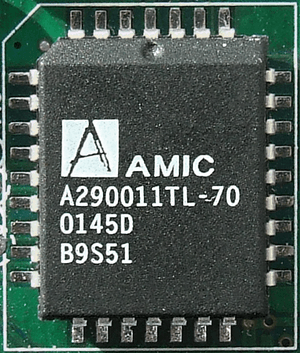EEPROM facts for kids
EEPROM (pronounced "E-E-PROM") stands for electrically erasable programmable read-only memory. It's a special type of computer memory that can hold information even when the power is turned off. This is called "non-volatile memory." Think of it like a digital notebook that remembers everything you write, even if you close it and put it away.
Unlike some other types of memory, EEPROM lets you erase and rewrite data many times using electricity. This makes it very useful for storing settings and small bits of information in devices like smart cards (like the ones in your phone or bank card) and remote keyless systems (like your car's remote).
Contents
What is EEPROM?
EEPROM is a kind of memory chip that keeps data safe without needing a constant power supply. This is why it's called "non-volatile." Imagine your video game console remembering your saved games even after you unplug it – that's thanks to non-volatile memory like EEPROM.
How EEPROM Works
EEPROM stores data by trapping tiny electrical charges in special parts of the chip. These charges represent the "0s" and "1s" that computers use to store information.
- Electrically Erasable: You can erase the data on an EEPROM chip using an electrical signal. This is different from older types of memory that needed special ultraviolet light to be erased.
- Programmable: You can write new information onto the chip. This means you can update the settings or data stored on it whenever needed.
- Read-Only Memory: While you can write to it, EEPROM is mainly designed for reading data. It's not as fast for writing as other types of memory, but it's great for storing important information that doesn't change often.
Where is EEPROM Used?
EEPROM chips are found in many everyday devices. They are perfect for storing small amounts of data that needs to be kept safe and updated sometimes.
- Smart Cards: Your SIM card in your phone, bank cards, and access cards often use EEPROM to store your personal information and security details.
- Car Remotes: The remote keyless entry system for your car uses EEPROM to store the unique code that unlocks your car.
- Computers and Electronics: EEPROM is used in computers to store basic input/output system (BIOS) settings, which are the instructions your computer uses to start up. It's also in many other electronic gadgets to save settings or calibration data.
- USB Flash Drives: While modern USB drives mostly use a similar technology called flash memory, EEPROM was an important step in developing these portable storage devices.
History of EEPROM
The idea behind EEPROM came from earlier types of memory. Scientists and engineers were always looking for better ways to store information.
Early Memory Types
Before EEPROM, there was EPROM (Erasable Programmable Read-Only Memory). EPROM chips could be erased, but it was a bit tricky. You had to remove the chip from the device and expose it to strong ultraviolet light through a small window on the chip. This wasn't very practical for devices that needed to be updated often.
The Invention of EEPROM
EEPROM was developed to solve the problem of needing UV light for erasing. It was invented in the late 1970s and early 1980s. This new technology allowed data to be erased and rewritten right inside the circuit, without removing the chip. This made it much easier to update settings in electronic devices.
- Key Developers: Many companies and researchers contributed to the development of EEPROM. Intel was one of the companies that played a significant role in bringing this technology to market.
- Impact: The invention of EEPROM was a big step forward for electronics. It made devices more flexible and easier to update, leading to many of the smart gadgets we use today.
Images for kids
-
Inside of a SIM card
See also
 In Spanish: EEPROM para niños
In Spanish: EEPROM para niños



